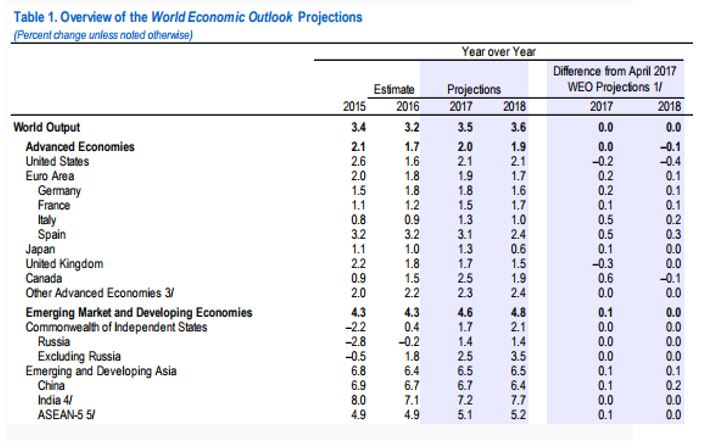Canada Will Likely Lead The G7 Countries Growth This Year, But Post Slower Growth In 2018
“Projected global growth rates for 2017–18, though higher than the 3.2 percent estimated for 2016, are below pre-crisis averages, especially for most advanced economies and for commodity-exporting emerging and developing economies. Among the former, many face excess capacity as well as headwinds to potential growth from aging populations, weak investment, and slowly advancing productivity.” (IMF, World Economic Outlook Update, July 24, 2017)
As the IMF highlights in its recent Update Report, there is growing evidence that a modest and synchronized upswing in the world economy is underway. Indeed, the IMF, the Organization for Economic Co-operation and Development, and the Bank of Canada have all upgraded their 2017 world GDP growth forecasts to 2.8%.
Despite a somewhat more promising global economic perspective, the outlook for the nearly fully employed U.S. economy is slightly less robust than in earlier forecasts.
The IMF now expects the U.S., the world’s largest economy, to expand only 2.1% in real terms in both 2017 and 2018. The recent downgrade in American growth is related to fading confidence in The Trump Administration to fully deliver on the expected economic boost from its promised tax cuts and infrastructure spending increases.
In its latest economic outlook, the IMF projects Canada’s economy to grow 2.5% this year and in effect become the growth leader among the G7 countries. However, the strengthening of the Canadian dollar (recently climbing to 80 cents U.S. in July) together with the slight down grade in U.S. growth next year will likely slow Canadian growth to about 1.9% in 2018.
The emerging market economies are projected to expand at a faster and more sustained pace in 2018 primarily because of the improving outlook for the developed economies, as well as some renewed optimism relating to depressed commodity prices.
The emerging market economies GDP growth should increase from 4.3% in 2016 to 4.6% in 2017 and 4.8% in 2018. China’s economy is projected to decelerate rather modestly next year, from 6.7% growth in 2017 to 6.4% in 2018. India’s economy is projected to continue to grow very rapidly, 7.2% in 2017 and 7.7% in 2018.
Returning to the Canadian economic outlook, it is rather obvious that the expectation of slower Canadian economic growth in 2018 results from the escalated value of the Canadian dollar and to the expectation that Canada’s central bank will be engaged in some monetary tightening next year.
Though this economist does not see inflation as a significant risk, the Bank of Canada believes that Canada’s economy will be roughly at full capacity in 2018, which according to their analysis, suggests some inflation risk.

Disclosure: None.



